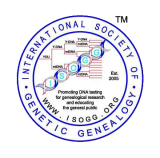Match
From ISOGG Wiki
(Redirected from Matches)In genetic genealogy a match is considered to exist when a comparison of the DNA test results of two persons suggests there is a high probability of them sharing a common genetic ancestor within a relevant period of time. The testing companies each set their own criteria to determine what constitutes a match, and the criteria vary depending on the type of test taken (Y chromosome DNA test, mitochondrial DNA test or autosomal DNA test).
Contents
Match notifications
At Family Tree DNA matching preferences can be adjusted on the My Privacy and Sharing Page.
Notifications about new matches can be set on the My Notifications Preference Page.
Y-STR matches
On the personal page of each testee Family Tree DNA list the Y chromosome DNA matches of that individual with other individuals in their database. The settings can be adjusted to show matches within the entire database or matches within the various projects that the individual has joined.
The minimum matching threshold at each testing level is as follows:
- 12/12 (0 steps) (testees are also notified of 11/12 matches within their projects)
- 23/25 (2 steps)
- 33/37 (4 steps)
- 60/67 (7 steps)
- 101/111 (10 steps)[1][2]
Only those people who have signed the FTDNA release form will appear in the match lists. The number of people who have not signed the release form is not known but is likely to be only a very small percentage of the database.
ISOGG surname project administrators have reported the minimum and maximum number of matches of individuals with other individuals in FTDNA's entire database as of October 2013 as follows:
| Number of markers | Minimum number of matches | Maximum number of matches |
|---|---|---|
| 12 | 0 | 9018 |
| 25 | 0 | 3140 |
| 37 | 0 | 1321 |
| 67 | 0 | 1332 |
| 111 | 0 | 99 |
The number of matches an individual may have depends on two factors:
1. The number of individuals tested. Many more testees have tested to 12 markers than to 111; the number of testees in FTDNA's entire Y-DNA database is very much more than than is found in any one of the nearly 8,000 surname projects that FTDNA host. (By June 2013, there were over half a million Y-DNA test results in the FTDNA database.) In addition, the number of testees in each project, and in the entire database, and hence the number of matches, are all growing continually.
2. The populations in the FTDNA database. The FTDNA database predominantly consists of testees of European origin, with Americans forming the largest grouping. Testees from under-represented populations (eg, Asians and Africans) are more likely to have fewer matches.
3. The rarity of the individual's haplotype. Some testees with particularly rare haplotypes will have no matches at all at any resolution level. It is estimated that less than 5% of those who have tested at FTDNA are in this situation. At the other extreme people can sometimes have thousands of matches. This usually happens when a person matches the the Irish Modal Haplotype (the signature which generates a "Niall of the Nine Hostages" badge) or the Western Atlantic Modal Haplotype.[3][4] Most people will have a much more manageable number of matches.
Ralph Taylor has written a detailed article Measuring haplotype rarity in which he attempts to quantify the commonness and rarity of Y-STR haplotypes.
FTDNA Learning Center articles
- Paternal lineage tests and matching for family history
- Y-DNA matches page
- Expected relationships with Y-DNA STR matches
- If two men share a surname, how should the genetic distance at 12 Y-Chromosome STR markers be interpreted?
- If two men share a surname, how should the genetic distance at 25 Y-Chromosome STR markers be interpreted?
- If two men share a surname, how should the genetic distance at 37 Y-Chromosome STR markers be interpreted?
- If two men share a surname, how should the genetic distance at 67 Y-Chromosome STR markers be interpreted?
- If two men share a surname, how should the genetic distance at 111 Y-Chromosome STR markers be interpreted?
Further reading
- Haplogrump by Jeremy Balkin, Breaking Genetics, 18 August 2015. An article on the problem of having no matches.
- Is the Y pool too shallow? by Roberta Estes. DNAeXplained blog, 11 October 2012.
Scientific papers
- Brenner CH (2014). Understanding Y haplotype matching probability. Forensic Science International: Genetics 8(1):233-243.
Autosomal DNA matches
Each company sets their own autosomal DNA match thresholds. These criteria must be met before the company will report that two individuals very likely inherited their half-identical matching segments from a recent common ancestor.
mtDNA matches
See also
- Portal:DNA Project Administration
- Convergence
- Genetic distance
- Matching and grouping in surname DNA projects
- SNP testing
- TiP
- Western Atlantic Modal Haplotype
- Y-DNA tools
References
- ↑ Are only exact matches shown? Family Tree DNA FAQ. Accessed 30 October 2013.
- ↑ Relevant matches. Family Tree DNA Privacy Policy. Accessed 29 October 2013.
- ↑ What does the Niall of the Nine Hostages badge on my personal page mean? Family Tree DNA FAQ. Accessed 28 October 2013.
- ↑ What does the WAMH badge on my personal page mean? Family Tree DNA FAQ. Accessed 28 October 2013.
